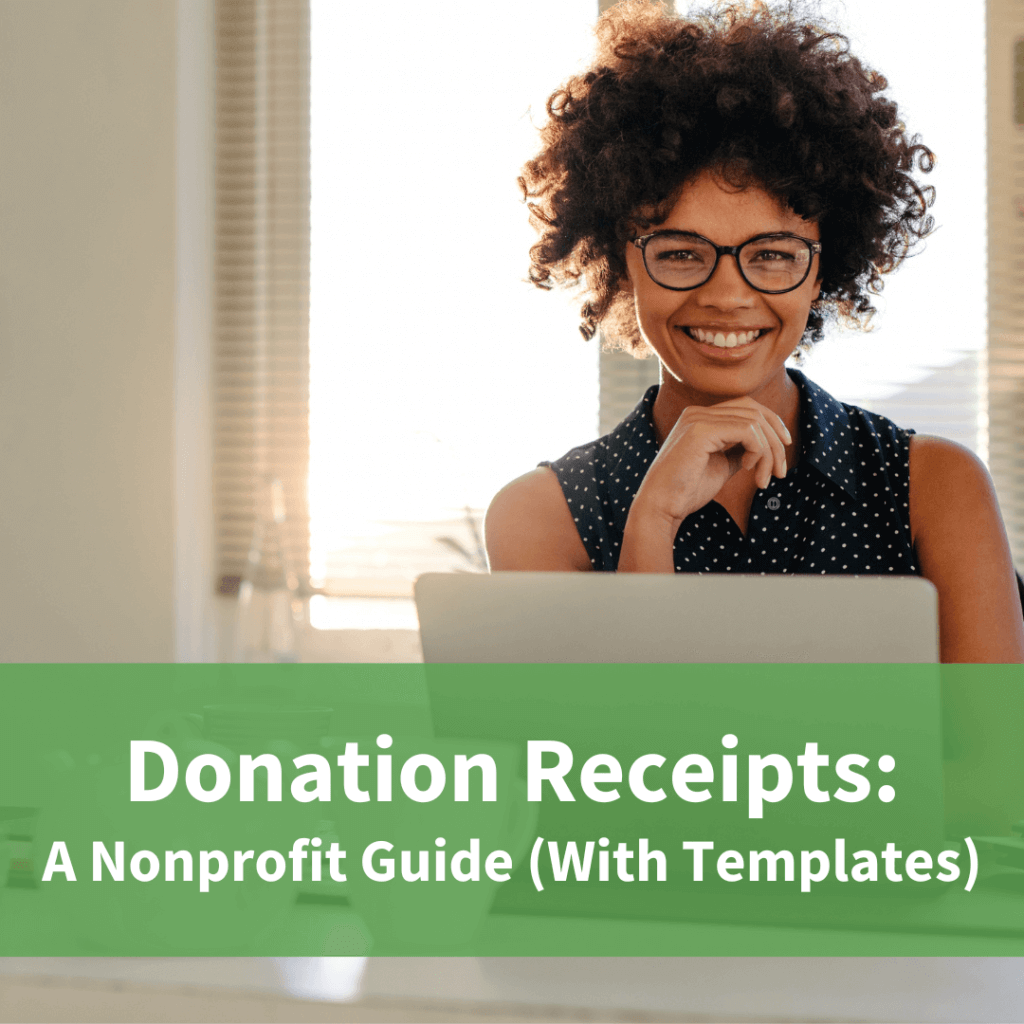So, a donation just came in, and you need to acknowledge the donation by sending a donation receipt letter, or the end of the year has rolled around, and it’s time to get busy generating year end receipts and statements.
Don’t stress out, here’s everything you need to know, including official US and Canadian donation receipt requirements, and templates!

We’ll cover:
- What are Charitable Donation Receipts
- When to Issue Donation Receipts
- What Should Donation Receipt Include
- Donation Receipt Templates
- Benefits of a 501c3 donation receipt
- Benefits of An Automated Donation Receipt Process
- Year-End Donation Receipt Statements
- Creating Template
- Pro-tips for Creating Donation Receipt Letters
What Are Charitable Donation Receipts
Putting it simply, a nonprofit donation receipt is a formal acknowledgement that a donation was made to your organization. It is often presented to donors as a letter or email after the donation is received.
When To Issue Donation Receipts
Receipts can be issued for in-kind or monetary donations and sent in monthly, yearly or ad hoc statements.
United States
The IRS requires a donation receipt in the following cases:
- Single donations over $250
- If a donor specifically requests for a donation receipt
- If a donor receives goods or services in exchange for a donation over $75 (calculate your donation receipt value for such transactions here)
- For non-monetary donations valued over $5,000, the item will need to be appraised by a professional to give tax benefits to donors.
While there is no legal requirement for you to send a donation receipt for gifts below $250, it is good practice and most nonprofits send acknowledgements for every donation.
Canada
The Canada Revenue Agency suggests that registered charities issue receipts by February 28 of the calendar year that follows the year of the donation. This allows individual taxpayers to claim their donations on their annual income tax returns.
What Should Donation Receipts Include
Generally speaking, receipts or written acknowledgments required to substantiate a charitable contribution must contain the following information:
- The legal name of your charity with an official address and your charitable registration number. (In the US this is not mandated, but is considered good practice to include)
- A unique serialized ID or receipt number to help you keep track of donations
- Signing authority at your organization, this could be your Executive Director or CEO
Donation Receipt Requirements – US and Canada
| Requirements for the U.S. | Requirements for Canada |
Source: IRS – Charitable Contributions: Substantiation and Disclosure Requirements |
Source: CRA – Operating a Registered Charity: Issuing Receipts |
Don’t forget to include a short thank you note with your year end receipts.
Donation Receipt Templates
We created these donation receipt templates for different giving scenarios in both the U.S. and Canada to help.

Types of Receipt Templates
- Charitable Donation Receipt: This is a standard donation receipt informing donors that their money has been received.
- In-Kind Donation Receipt: You’ll need to write an in-kind donation receipt for donations of goods and services. The value of these gifts must be determined by the donor or a professional appraiser. Gifts of time or service don’t hold a dollar value and aren’t eligible for receipts.
- Cash Donation Receipt: Gifts of cash also require donation receipts. This provides your nonprofit with written evidence of the cash and can be used by donors to deduct the amount from their taxable income.
- Stock Gift Donation Receipt: This donation receipt should include details of the gift of stock shares of a company – including number of shares and name of the company (but not the dollar equivalent of the shares).
When adding an advantage to your donation receipt, remember to subtract the value of the advantage from the donation amount.
Use our donation receipt value calculator to easily determine the eligible amount of the gift.
Benefits Of A 501c3 Donation Receipt
Donation receipts are financially important to donors. Charitable organizations, classified as 501(c)(3) organizations in the US, enable donors to claim tax benefits on their donations – but need a 501c3 donation receipt as proof.
If your nonprofit is a registered charity (i.e exempt from tax), donors can claim tax benefits by presenting their donation receipts to the IRS, so it’s important you issue them correctly and on time.
For smaller nonprofits pressed for time, it’s tempting to ignore donation receipts until the very last minute, or think of them as a compliance issue, but donation receipt letters are important.
Not only are they required as evidence of a donor’s contribution to your nonprofit, but they give you an opportunity to express gratitude, which is crucial to establishing great relationships with your donors (Pssst. don’t forget to send a thank you note along with your donation receipt. Learn how to write a great thank you letter).
Besides tax saving, here are the benefits of issuing 501c3 donation receipts:
For Donors:
- Helps donors receive beneficial tax deductions on their income for the year
- Donation receipts serve as a written record of their contribution and confirms you have received their donation
- Helps donors keep track of their finances
For your nonprofit:
- Customized, prompt and well-designed donation receipts can help you establish good relationships with your donors and keep them engaged
- 501c3 donation receipts can also induce donors to give (or give more) – so make sure they’re aware of your nonprofit status.
- Donation receipts are a good opportunity to thank donors and make them feel appreciated – which encourages future giving
- Helps keep track of donors’ giving history with your organization so you can customize asks in the future
- Helps you keep accurate financial records. Having a clear sense of yearly donations (and their source) can also help set targeted fundraising goals and forecast expected revenue
- Legal compliance: The IRS requires donation receipts for most donations. Failure to issue receipts can incur a penalty of $10 per donation and go to $5,000 for a specific campaign.
Benefits of an Automated Donation Receipt Process
Did you know donors are more likely to give again if their donations are acknowledged within the first 48 hours?
This is why it pays to have a nonprofit CRM like Sumac that automates the sending of donation receipt letters.
Failing to send prompt donation receipts can leave donors feeling forgotten, and unsure whether their donation was received, especially with online donations.
If you have a large volume of individual donations coming in throughout the year, automating the donation receipt process might be a good idea.
For example, Sumac donor management system personalizes and sends donation receipts right after a donation. The donation page also sends automatic receipts to donors who give on your website immediately after the donation is made. Benefits of automation include:
- Consolidated database of all donors and donation amounts
- Customized templates for different types of donations
- Populates automated yearly statements to help donors with end-of-year taxes
- Creates personalized donation receipt letters
- Saves you and your team valuable time and reduces chances of error
Year-End Donation Receipt Statements
If your organization issues receipts after each donation, then you may not have to send anything at the end of the year, but it’s still a good idea.
An year-end statement is a simple letter that reminds donors what they contributed over the year. It makes it easier for donors to organize their records and get ready to file taxes without the hassle of searching for multiple single donation receipts.
Pro-tip: Send year-end donation receipts before January 31st to give donors time to process their taxes!
Creating Templates
Now that you know what to include in your year end donation statements and receipts, you can create a template.
Your nonprofit database should allow you to define what information to include and where it goes, so if you need to show the original pledge amount along with what’s been donated, or add a statement like “no goods or services were provided by the organization in return for the contribution”, you can do that.
Once you’ve got the template done, you’ll just need to select your donors, do a mail merge and then print or email. Be sure to set the date range for donations made between January 1st, and December 31st.
If you use Sumac, here are some donation receipt templates for both the U.S. And Canada. If you send paper receipts, you can generate them as word processing documents, then print them. If you want to send electronic receipts, on the other hand, you can generate them as unchangeable PDF documents, which satisfy government requirements for electronic receipting.
Pro-tips for Creating Donation Receipt Letters
- Make it personal: Mention your donor’s name in your donation receipt! Instead of sending a separate thank you letter – see if you can create a 501c3 donation receipt template that includes both IRS required elements along with a personal note.
- Set a threshold for donation receipt letters: If you’re unable to automate this process yet, set a threshold for receipting. For example, you can decide to send donation receipts only for amounts higher than $20. (Ideally, everyone should get a receipt and a thank you!)
- Send annual donation receipts: As stated earlier, an annual summary of donations will make it easier for donors – and their appreciation could take the form of more donations!
- Use donation receipts as an opportunity to engage donors: Donation receipts are an opportunity to communicate with your donors – try including a note that highlights the impact of their gift and makes them feel valued and appreciated. Don’t ask for anything more – this is the time to say thank you!
- Store and organize donation receipts carefully: Make sure your data is well organised and backed up – download copies of all receipts if you’re using a cloud-based system. Give donation receipts a unique number or ID to help you find them easily.
- Keep your team informed: Make donation acceptance policies transparent to team members and donors. Conduct a session on the rules of correct receipting and communicate any changes regularly.
- Don’t tell donors they’ll save on tax: Stating that donations are exempt from tax on 501c3 donation receipt templates might backfire, as this depends on an individual’s tax bracket. If you wish to include such a statement, make sure it clearly states donations may be eligible for tax benefits.
Whether you’re using a nonprofit CRM or a donor management software or a spreadsheet, we’re sure you’ll be able to process those donation receipts quickly and easily. Don’t forget to familiarize yourself with nonprofit donation receipt requirements in your country before creating your donation receipt templates!
Once you’ve figured out your process you’ll be able to focus more on fundraising campaigns and activities that keep your donations rolling in!
About the Author: Sumac is part of the Societ family, a company dedicated to providing exceptional software and services to nonprofits. With over 25 years of service, Silent Partner has helped organizations manage over 3 million donors and contacts across the US, Canada, UK, and Europe. Learn more here.




